Leadership Development Plan: Self-Reflection Report
VerifiedAdded on 2022/09/18
|14
|4257
|25
Report
AI Summary
This report presents a leadership development plan, focusing on self-awareness and personal growth. It begins with an executive summary and an introduction that emphasizes the evolving concept of dynamic leadership, highlighting the importance of empowering others. The report then explores the significance of personal development for leaders, stressing the need for self-awareness to enhance skills and achieve leadership goals. It uses Richard Boyatzis' change model to outline steps for self-development, including imagining an ideal self, comparing it to the real self, developing a learning agenda, trying out desired changes, and developing relationships. The report evaluates the author's leadership styles, identifying both coach-style and strategic leadership styles, and discusses the characteristics of each. Finally, a personal leadership development plan is presented, outlining steps to enhance skills and achieve career goals through self-assessment, core value development, and skill improvement over a two-year timeframe, incorporating inspiration from other leaders, ethical behavior, creativity, and intellectual skills to guide actions in critical situations.
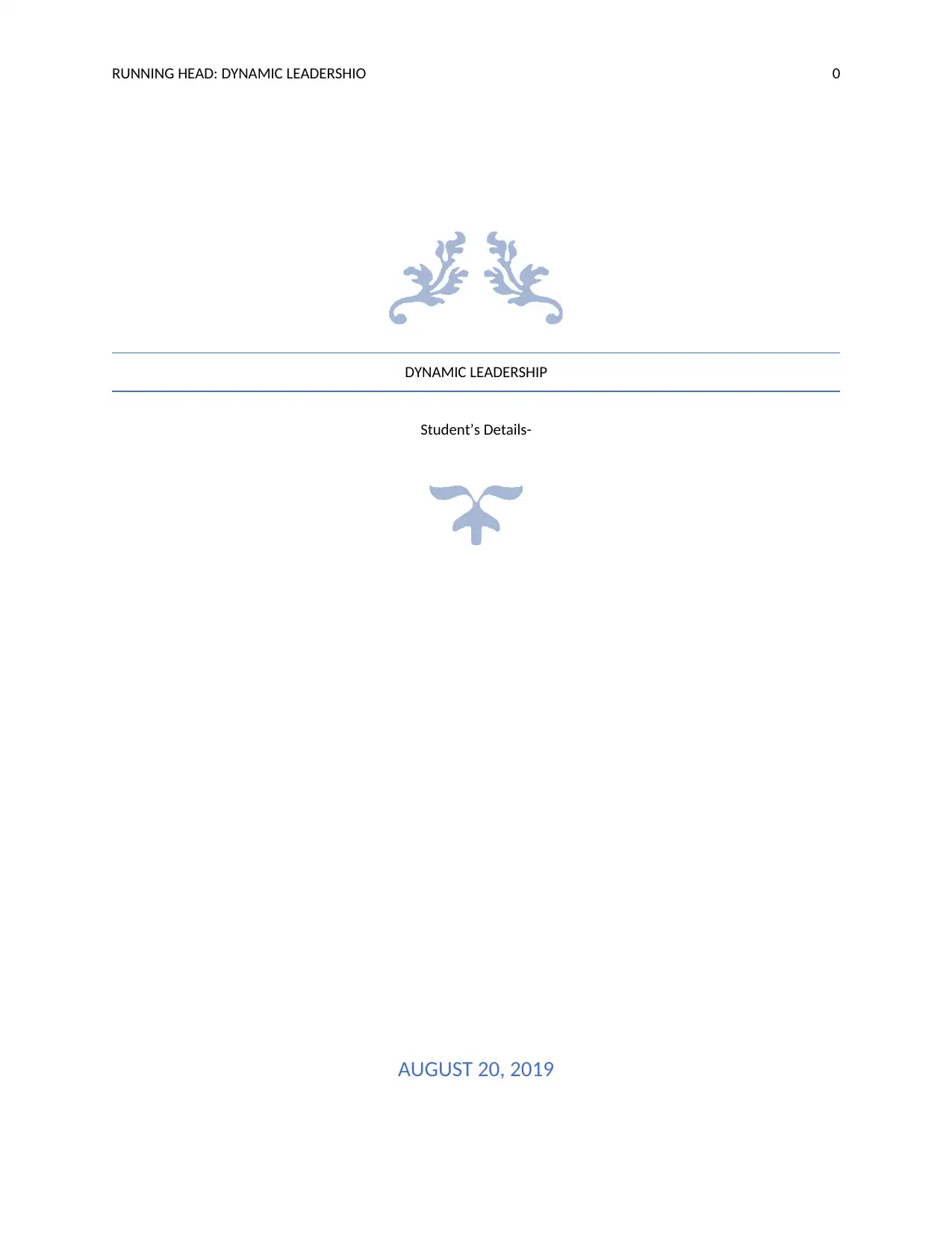
RUNNING HEAD: DYNAMIC LEADERSHIO 0
DYNAMIC LEADERSHIP
Student’s Details-
AUGUST 20, 2019
DYNAMIC LEADERSHIP
Student’s Details-
AUGUST 20, 2019
Paraphrase This Document
Need a fresh take? Get an instant paraphrase of this document with our AI Paraphraser
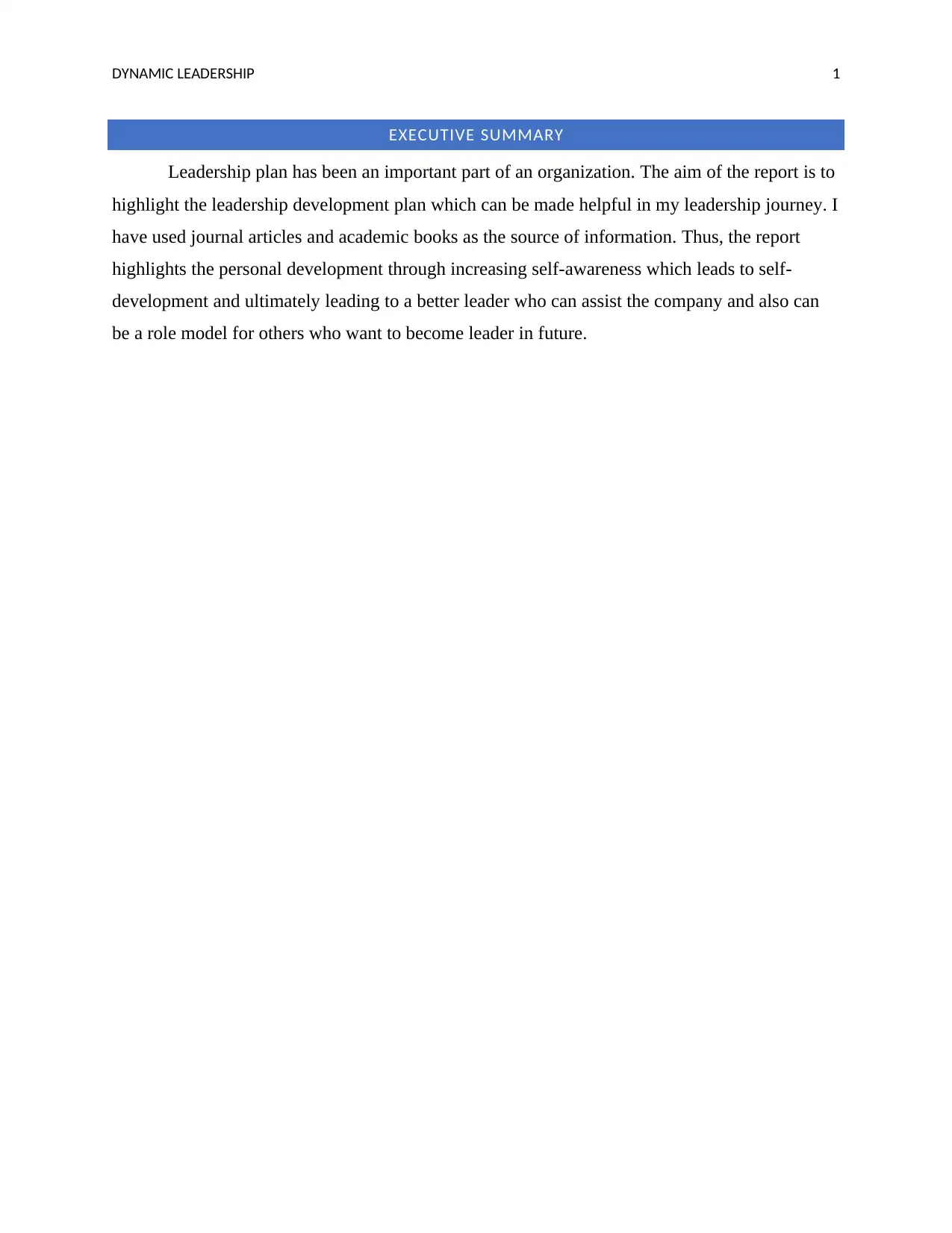
DYNAMIC LEADERSHIP 1
EXECUTIVE SUMMARY
Leadership plan has been an important part of an organization. The aim of the report is to
highlight the leadership development plan which can be made helpful in my leadership journey. I
have used journal articles and academic books as the source of information. Thus, the report
highlights the personal development through increasing self-awareness which leads to self-
development and ultimately leading to a better leader who can assist the company and also can
be a role model for others who want to become leader in future.
EXECUTIVE SUMMARY
Leadership plan has been an important part of an organization. The aim of the report is to
highlight the leadership development plan which can be made helpful in my leadership journey. I
have used journal articles and academic books as the source of information. Thus, the report
highlights the personal development through increasing self-awareness which leads to self-
development and ultimately leading to a better leader who can assist the company and also can
be a role model for others who want to become leader in future.
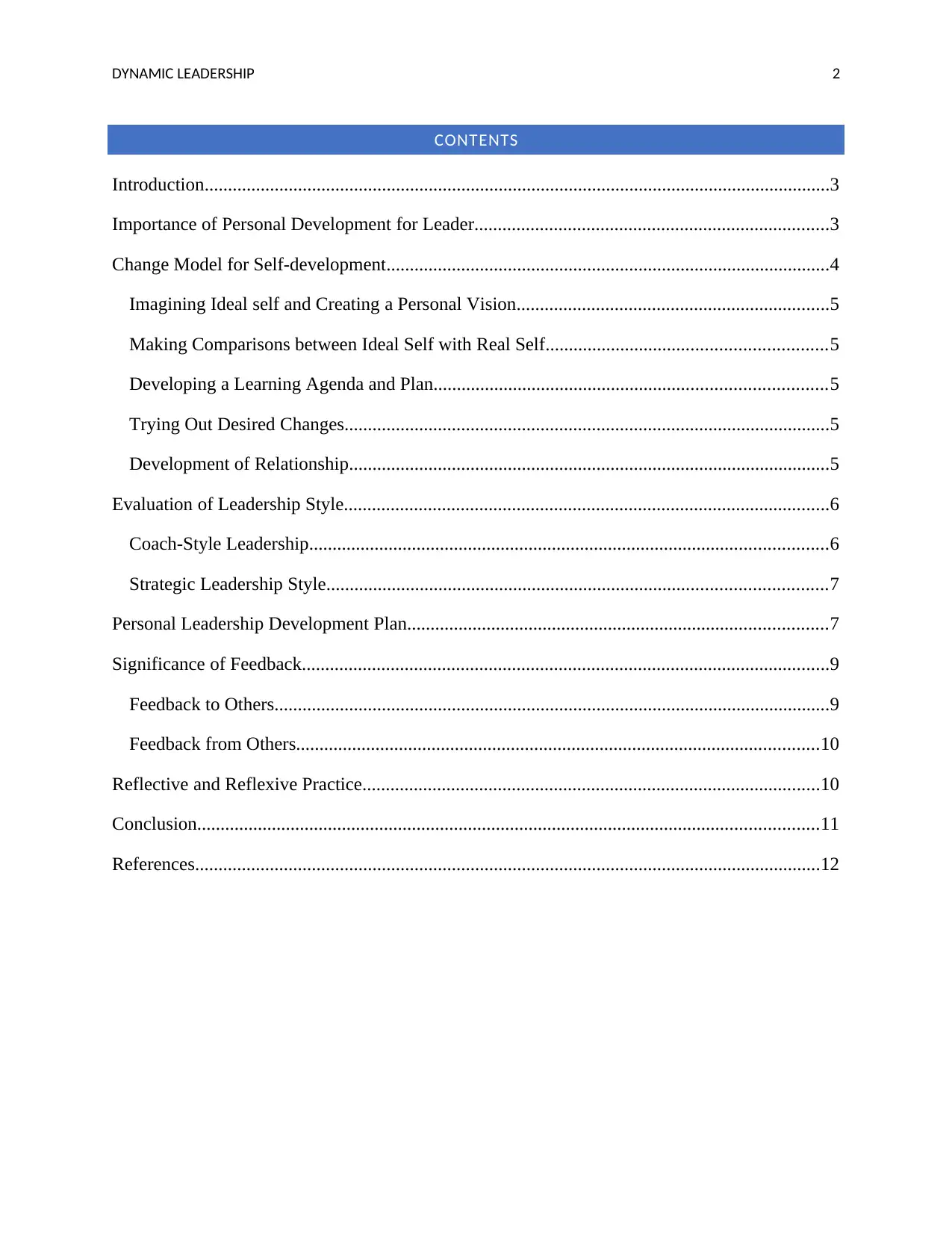
DYNAMIC LEADERSHIP 2
CONTENTS
Introduction......................................................................................................................................3
Importance of Personal Development for Leader............................................................................3
Change Model for Self-development...............................................................................................4
Imagining Ideal self and Creating a Personal Vision...................................................................5
Making Comparisons between Ideal Self with Real Self............................................................5
Developing a Learning Agenda and Plan....................................................................................5
Trying Out Desired Changes........................................................................................................5
Development of Relationship.......................................................................................................5
Evaluation of Leadership Style........................................................................................................6
Coach-Style Leadership...............................................................................................................6
Strategic Leadership Style...........................................................................................................7
Personal Leadership Development Plan..........................................................................................7
Significance of Feedback.................................................................................................................9
Feedback to Others.......................................................................................................................9
Feedback from Others................................................................................................................10
Reflective and Reflexive Practice..................................................................................................10
Conclusion.....................................................................................................................................11
References......................................................................................................................................12
CONTENTS
Introduction......................................................................................................................................3
Importance of Personal Development for Leader............................................................................3
Change Model for Self-development...............................................................................................4
Imagining Ideal self and Creating a Personal Vision...................................................................5
Making Comparisons between Ideal Self with Real Self............................................................5
Developing a Learning Agenda and Plan....................................................................................5
Trying Out Desired Changes........................................................................................................5
Development of Relationship.......................................................................................................5
Evaluation of Leadership Style........................................................................................................6
Coach-Style Leadership...............................................................................................................6
Strategic Leadership Style...........................................................................................................7
Personal Leadership Development Plan..........................................................................................7
Significance of Feedback.................................................................................................................9
Feedback to Others.......................................................................................................................9
Feedback from Others................................................................................................................10
Reflective and Reflexive Practice..................................................................................................10
Conclusion.....................................................................................................................................11
References......................................................................................................................................12
⊘ This is a preview!⊘
Do you want full access?
Subscribe today to unlock all pages.

Trusted by 1+ million students worldwide
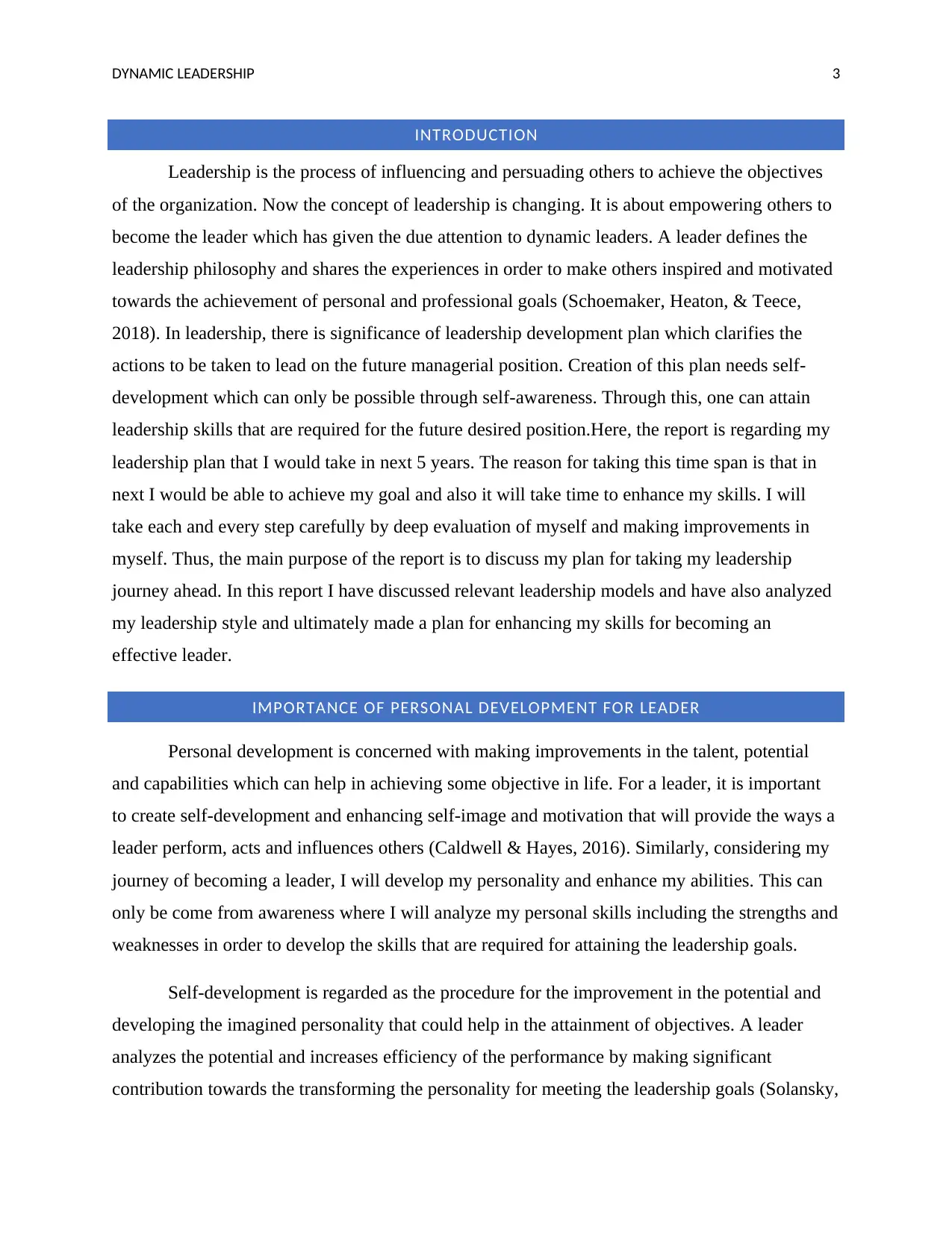
DYNAMIC LEADERSHIP 3
INTRODUCTION
Leadership is the process of influencing and persuading others to achieve the objectives
of the organization. Now the concept of leadership is changing. It is about empowering others to
become the leader which has given the due attention to dynamic leaders. A leader defines the
leadership philosophy and shares the experiences in order to make others inspired and motivated
towards the achievement of personal and professional goals (Schoemaker, Heaton, & Teece,
2018). In leadership, there is significance of leadership development plan which clarifies the
actions to be taken to lead on the future managerial position. Creation of this plan needs self-
development which can only be possible through self-awareness. Through this, one can attain
leadership skills that are required for the future desired position.Here, the report is regarding my
leadership plan that I would take in next 5 years. The reason for taking this time span is that in
next I would be able to achieve my goal and also it will take time to enhance my skills. I will
take each and every step carefully by deep evaluation of myself and making improvements in
myself. Thus, the main purpose of the report is to discuss my plan for taking my leadership
journey ahead. In this report I have discussed relevant leadership models and have also analyzed
my leadership style and ultimately made a plan for enhancing my skills for becoming an
effective leader.
IMPORTANCE OF PERSONAL DEVELOPMENT FOR LEADER
Personal development is concerned with making improvements in the talent, potential
and capabilities which can help in achieving some objective in life. For a leader, it is important
to create self-development and enhancing self-image and motivation that will provide the ways a
leader perform, acts and influences others (Caldwell & Hayes, 2016). Similarly, considering my
journey of becoming a leader, I will develop my personality and enhance my abilities. This can
only be come from awareness where I will analyze my personal skills including the strengths and
weaknesses in order to develop the skills that are required for attaining the leadership goals.
Self-development is regarded as the procedure for the improvement in the potential and
developing the imagined personality that could help in the attainment of objectives. A leader
analyzes the potential and increases efficiency of the performance by making significant
contribution towards the transforming the personality for meeting the leadership goals (Solansky,
INTRODUCTION
Leadership is the process of influencing and persuading others to achieve the objectives
of the organization. Now the concept of leadership is changing. It is about empowering others to
become the leader which has given the due attention to dynamic leaders. A leader defines the
leadership philosophy and shares the experiences in order to make others inspired and motivated
towards the achievement of personal and professional goals (Schoemaker, Heaton, & Teece,
2018). In leadership, there is significance of leadership development plan which clarifies the
actions to be taken to lead on the future managerial position. Creation of this plan needs self-
development which can only be possible through self-awareness. Through this, one can attain
leadership skills that are required for the future desired position.Here, the report is regarding my
leadership plan that I would take in next 5 years. The reason for taking this time span is that in
next I would be able to achieve my goal and also it will take time to enhance my skills. I will
take each and every step carefully by deep evaluation of myself and making improvements in
myself. Thus, the main purpose of the report is to discuss my plan for taking my leadership
journey ahead. In this report I have discussed relevant leadership models and have also analyzed
my leadership style and ultimately made a plan for enhancing my skills for becoming an
effective leader.
IMPORTANCE OF PERSONAL DEVELOPMENT FOR LEADER
Personal development is concerned with making improvements in the talent, potential
and capabilities which can help in achieving some objective in life. For a leader, it is important
to create self-development and enhancing self-image and motivation that will provide the ways a
leader perform, acts and influences others (Caldwell & Hayes, 2016). Similarly, considering my
journey of becoming a leader, I will develop my personality and enhance my abilities. This can
only be come from awareness where I will analyze my personal skills including the strengths and
weaknesses in order to develop the skills that are required for attaining the leadership goals.
Self-development is regarded as the procedure for the improvement in the potential and
developing the imagined personality that could help in the attainment of objectives. A leader
analyzes the potential and increases efficiency of the performance by making significant
contribution towards the transforming the personality for meeting the leadership goals (Solansky,
Paraphrase This Document
Need a fresh take? Get an instant paraphrase of this document with our AI Paraphraser
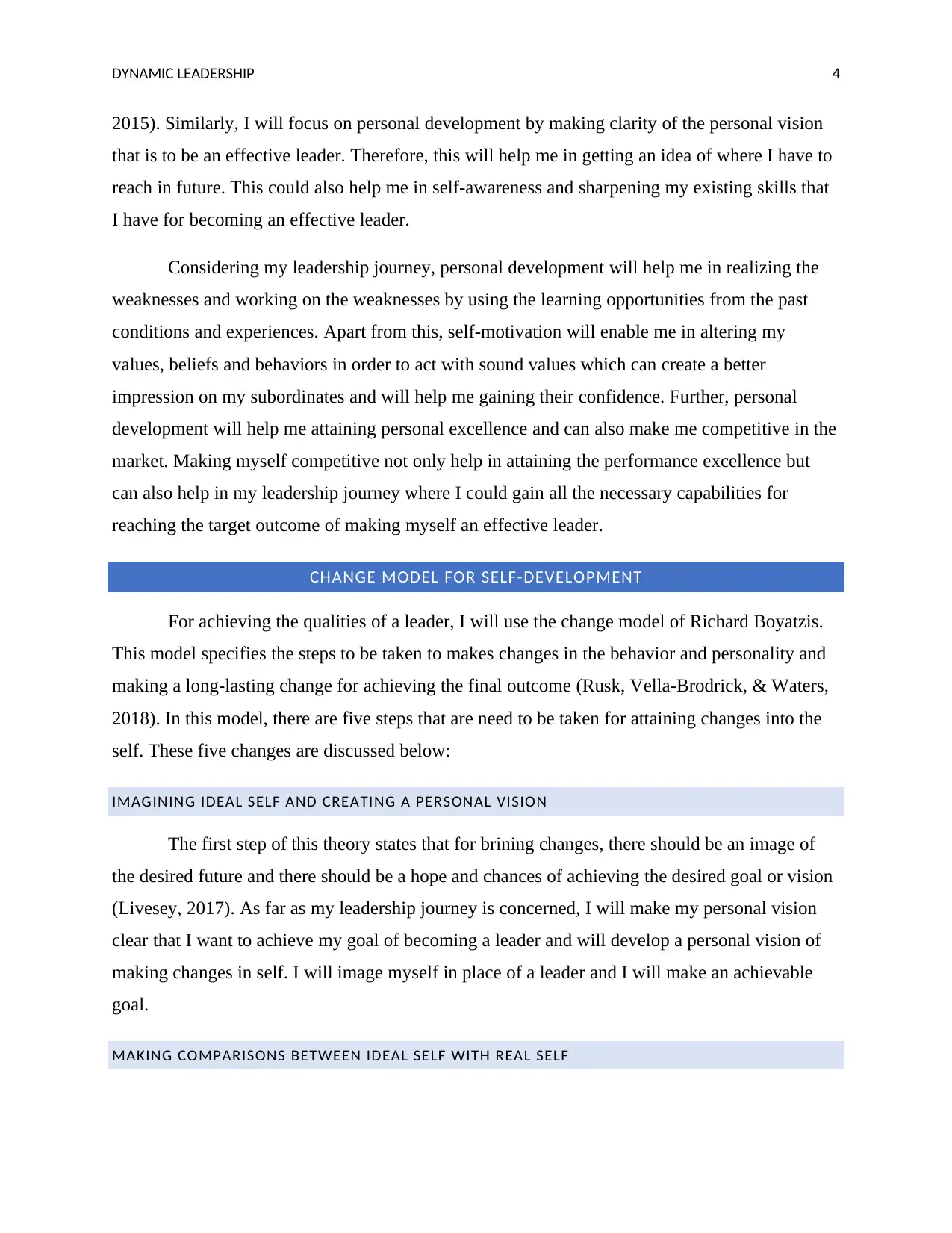
DYNAMIC LEADERSHIP 4
2015). Similarly, I will focus on personal development by making clarity of the personal vision
that is to be an effective leader. Therefore, this will help me in getting an idea of where I have to
reach in future. This could also help me in self-awareness and sharpening my existing skills that
I have for becoming an effective leader.
Considering my leadership journey, personal development will help me in realizing the
weaknesses and working on the weaknesses by using the learning opportunities from the past
conditions and experiences. Apart from this, self-motivation will enable me in altering my
values, beliefs and behaviors in order to act with sound values which can create a better
impression on my subordinates and will help me gaining their confidence. Further, personal
development will help me attaining personal excellence and can also make me competitive in the
market. Making myself competitive not only help in attaining the performance excellence but
can also help in my leadership journey where I could gain all the necessary capabilities for
reaching the target outcome of making myself an effective leader.
CHANGE MODEL FOR SELF-DEVELOPMENT
For achieving the qualities of a leader, I will use the change model of Richard Boyatzis.
This model specifies the steps to be taken to makes changes in the behavior and personality and
making a long-lasting change for achieving the final outcome (Rusk, Vella-Brodrick, & Waters,
2018). In this model, there are five steps that are need to be taken for attaining changes into the
self. These five changes are discussed below:
IMAGINING IDEAL SELF AND CREATING A PERSONAL VISION
The first step of this theory states that for brining changes, there should be an image of
the desired future and there should be a hope and chances of achieving the desired goal or vision
(Livesey, 2017). As far as my leadership journey is concerned, I will make my personal vision
clear that I want to achieve my goal of becoming a leader and will develop a personal vision of
making changes in self. I will image myself in place of a leader and I will make an achievable
goal.
MAKING COMPARISONS BETWEEN IDEAL SELF WITH REAL SELF
2015). Similarly, I will focus on personal development by making clarity of the personal vision
that is to be an effective leader. Therefore, this will help me in getting an idea of where I have to
reach in future. This could also help me in self-awareness and sharpening my existing skills that
I have for becoming an effective leader.
Considering my leadership journey, personal development will help me in realizing the
weaknesses and working on the weaknesses by using the learning opportunities from the past
conditions and experiences. Apart from this, self-motivation will enable me in altering my
values, beliefs and behaviors in order to act with sound values which can create a better
impression on my subordinates and will help me gaining their confidence. Further, personal
development will help me attaining personal excellence and can also make me competitive in the
market. Making myself competitive not only help in attaining the performance excellence but
can also help in my leadership journey where I could gain all the necessary capabilities for
reaching the target outcome of making myself an effective leader.
CHANGE MODEL FOR SELF-DEVELOPMENT
For achieving the qualities of a leader, I will use the change model of Richard Boyatzis.
This model specifies the steps to be taken to makes changes in the behavior and personality and
making a long-lasting change for achieving the final outcome (Rusk, Vella-Brodrick, & Waters,
2018). In this model, there are five steps that are need to be taken for attaining changes into the
self. These five changes are discussed below:
IMAGINING IDEAL SELF AND CREATING A PERSONAL VISION
The first step of this theory states that for brining changes, there should be an image of
the desired future and there should be a hope and chances of achieving the desired goal or vision
(Livesey, 2017). As far as my leadership journey is concerned, I will make my personal vision
clear that I want to achieve my goal of becoming a leader and will develop a personal vision of
making changes in self. I will image myself in place of a leader and I will make an achievable
goal.
MAKING COMPARISONS BETWEEN IDEAL SELF WITH REAL SELF
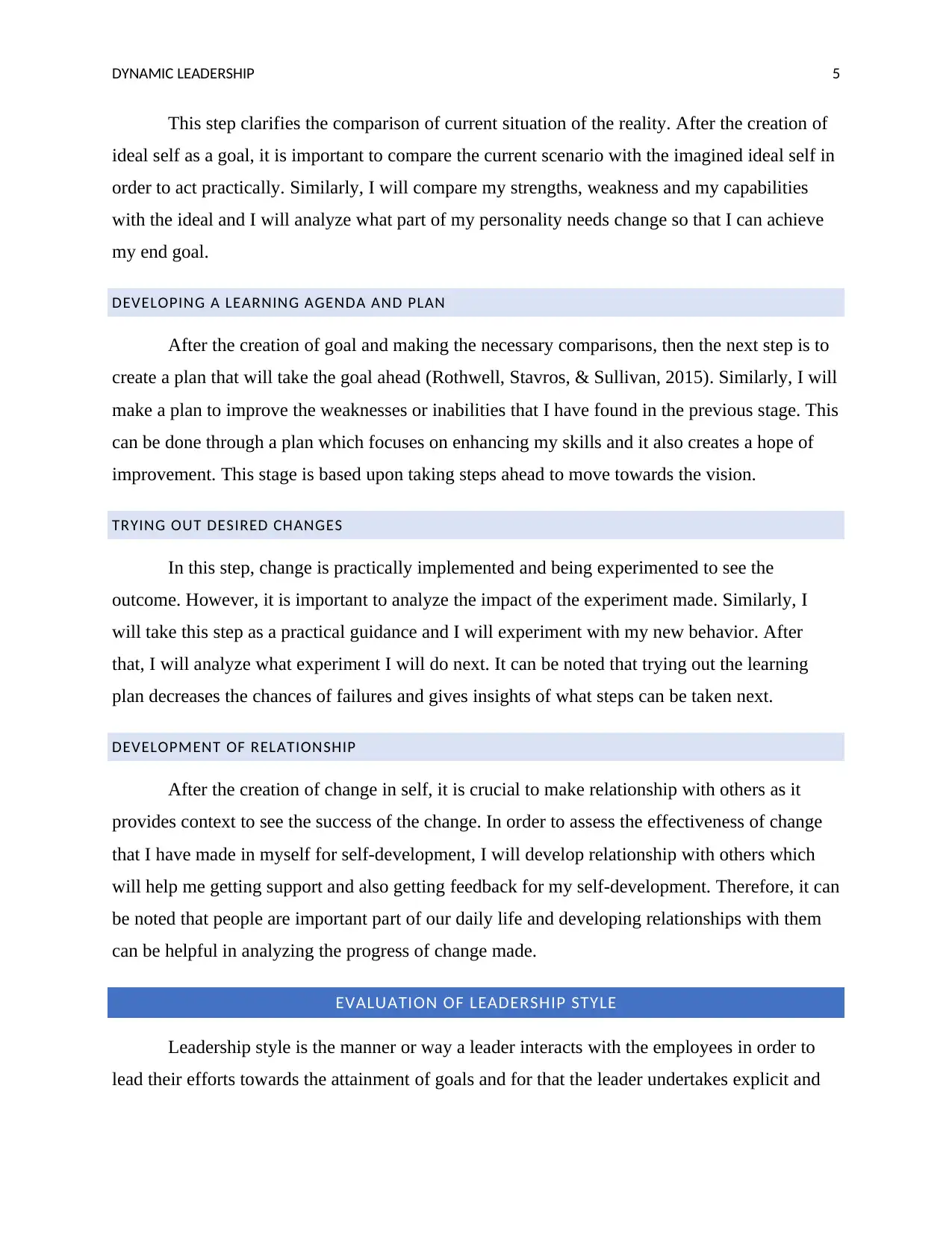
DYNAMIC LEADERSHIP 5
This step clarifies the comparison of current situation of the reality. After the creation of
ideal self as a goal, it is important to compare the current scenario with the imagined ideal self in
order to act practically. Similarly, I will compare my strengths, weakness and my capabilities
with the ideal and I will analyze what part of my personality needs change so that I can achieve
my end goal.
DEVELOPING A LEARNING AGENDA AND PLAN
After the creation of goal and making the necessary comparisons, then the next step is to
create a plan that will take the goal ahead (Rothwell, Stavros, & Sullivan, 2015). Similarly, I will
make a plan to improve the weaknesses or inabilities that I have found in the previous stage. This
can be done through a plan which focuses on enhancing my skills and it also creates a hope of
improvement. This stage is based upon taking steps ahead to move towards the vision.
TRYING OUT DESIRED CHANGES
In this step, change is practically implemented and being experimented to see the
outcome. However, it is important to analyze the impact of the experiment made. Similarly, I
will take this step as a practical guidance and I will experiment with my new behavior. After
that, I will analyze what experiment I will do next. It can be noted that trying out the learning
plan decreases the chances of failures and gives insights of what steps can be taken next.
DEVELOPMENT OF RELATIONSHIP
After the creation of change in self, it is crucial to make relationship with others as it
provides context to see the success of the change. In order to assess the effectiveness of change
that I have made in myself for self-development, I will develop relationship with others which
will help me getting support and also getting feedback for my self-development. Therefore, it can
be noted that people are important part of our daily life and developing relationships with them
can be helpful in analyzing the progress of change made.
EVALUATION OF LEADERSHIP STYLE
Leadership style is the manner or way a leader interacts with the employees in order to
lead their efforts towards the attainment of goals and for that the leader undertakes explicit and
This step clarifies the comparison of current situation of the reality. After the creation of
ideal self as a goal, it is important to compare the current scenario with the imagined ideal self in
order to act practically. Similarly, I will compare my strengths, weakness and my capabilities
with the ideal and I will analyze what part of my personality needs change so that I can achieve
my end goal.
DEVELOPING A LEARNING AGENDA AND PLAN
After the creation of goal and making the necessary comparisons, then the next step is to
create a plan that will take the goal ahead (Rothwell, Stavros, & Sullivan, 2015). Similarly, I will
make a plan to improve the weaknesses or inabilities that I have found in the previous stage. This
can be done through a plan which focuses on enhancing my skills and it also creates a hope of
improvement. This stage is based upon taking steps ahead to move towards the vision.
TRYING OUT DESIRED CHANGES
In this step, change is practically implemented and being experimented to see the
outcome. However, it is important to analyze the impact of the experiment made. Similarly, I
will take this step as a practical guidance and I will experiment with my new behavior. After
that, I will analyze what experiment I will do next. It can be noted that trying out the learning
plan decreases the chances of failures and gives insights of what steps can be taken next.
DEVELOPMENT OF RELATIONSHIP
After the creation of change in self, it is crucial to make relationship with others as it
provides context to see the success of the change. In order to assess the effectiveness of change
that I have made in myself for self-development, I will develop relationship with others which
will help me getting support and also getting feedback for my self-development. Therefore, it can
be noted that people are important part of our daily life and developing relationships with them
can be helpful in analyzing the progress of change made.
EVALUATION OF LEADERSHIP STYLE
Leadership style is the manner or way a leader interacts with the employees in order to
lead their efforts towards the attainment of goals and for that the leader undertakes explicit and
⊘ This is a preview!⊘
Do you want full access?
Subscribe today to unlock all pages.

Trusted by 1+ million students worldwide
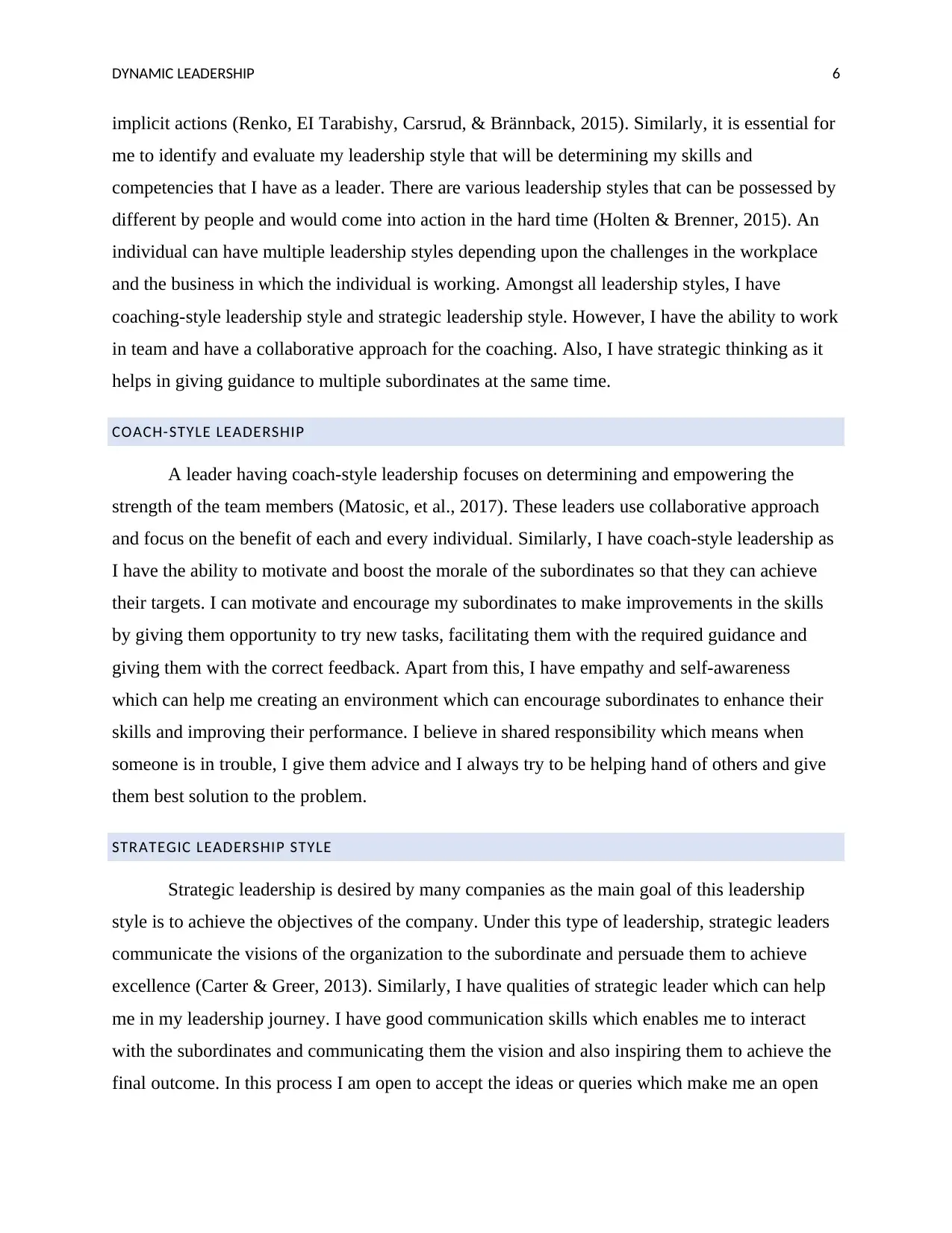
DYNAMIC LEADERSHIP 6
implicit actions (Renko, EI Tarabishy, Carsrud, & Brännback, 2015). Similarly, it is essential for
me to identify and evaluate my leadership style that will be determining my skills and
competencies that I have as a leader. There are various leadership styles that can be possessed by
different by people and would come into action in the hard time (Holten & Brenner, 2015). An
individual can have multiple leadership styles depending upon the challenges in the workplace
and the business in which the individual is working. Amongst all leadership styles, I have
coaching-style leadership style and strategic leadership style. However, I have the ability to work
in team and have a collaborative approach for the coaching. Also, I have strategic thinking as it
helps in giving guidance to multiple subordinates at the same time.
COACH-STYLE LEADERSHIP
A leader having coach-style leadership focuses on determining and empowering the
strength of the team members (Matosic, et al., 2017). These leaders use collaborative approach
and focus on the benefit of each and every individual. Similarly, I have coach-style leadership as
I have the ability to motivate and boost the morale of the subordinates so that they can achieve
their targets. I can motivate and encourage my subordinates to make improvements in the skills
by giving them opportunity to try new tasks, facilitating them with the required guidance and
giving them with the correct feedback. Apart from this, I have empathy and self-awareness
which can help me creating an environment which can encourage subordinates to enhance their
skills and improving their performance. I believe in shared responsibility which means when
someone is in trouble, I give them advice and I always try to be helping hand of others and give
them best solution to the problem.
STRATEGIC LEADERSHIP STYLE
Strategic leadership is desired by many companies as the main goal of this leadership
style is to achieve the objectives of the company. Under this type of leadership, strategic leaders
communicate the visions of the organization to the subordinate and persuade them to achieve
excellence (Carter & Greer, 2013). Similarly, I have qualities of strategic leader which can help
me in my leadership journey. I have good communication skills which enables me to interact
with the subordinates and communicating them the vision and also inspiring them to achieve the
final outcome. In this process I am open to accept the ideas or queries which make me an open
implicit actions (Renko, EI Tarabishy, Carsrud, & Brännback, 2015). Similarly, it is essential for
me to identify and evaluate my leadership style that will be determining my skills and
competencies that I have as a leader. There are various leadership styles that can be possessed by
different by people and would come into action in the hard time (Holten & Brenner, 2015). An
individual can have multiple leadership styles depending upon the challenges in the workplace
and the business in which the individual is working. Amongst all leadership styles, I have
coaching-style leadership style and strategic leadership style. However, I have the ability to work
in team and have a collaborative approach for the coaching. Also, I have strategic thinking as it
helps in giving guidance to multiple subordinates at the same time.
COACH-STYLE LEADERSHIP
A leader having coach-style leadership focuses on determining and empowering the
strength of the team members (Matosic, et al., 2017). These leaders use collaborative approach
and focus on the benefit of each and every individual. Similarly, I have coach-style leadership as
I have the ability to motivate and boost the morale of the subordinates so that they can achieve
their targets. I can motivate and encourage my subordinates to make improvements in the skills
by giving them opportunity to try new tasks, facilitating them with the required guidance and
giving them with the correct feedback. Apart from this, I have empathy and self-awareness
which can help me creating an environment which can encourage subordinates to enhance their
skills and improving their performance. I believe in shared responsibility which means when
someone is in trouble, I give them advice and I always try to be helping hand of others and give
them best solution to the problem.
STRATEGIC LEADERSHIP STYLE
Strategic leadership is desired by many companies as the main goal of this leadership
style is to achieve the objectives of the company. Under this type of leadership, strategic leaders
communicate the visions of the organization to the subordinate and persuade them to achieve
excellence (Carter & Greer, 2013). Similarly, I have qualities of strategic leader which can help
me in my leadership journey. I have good communication skills which enables me to interact
with the subordinates and communicating them the vision and also inspiring them to achieve the
final outcome. In this process I am open to accept the ideas or queries which make me an open
Paraphrase This Document
Need a fresh take? Get an instant paraphrase of this document with our AI Paraphraser
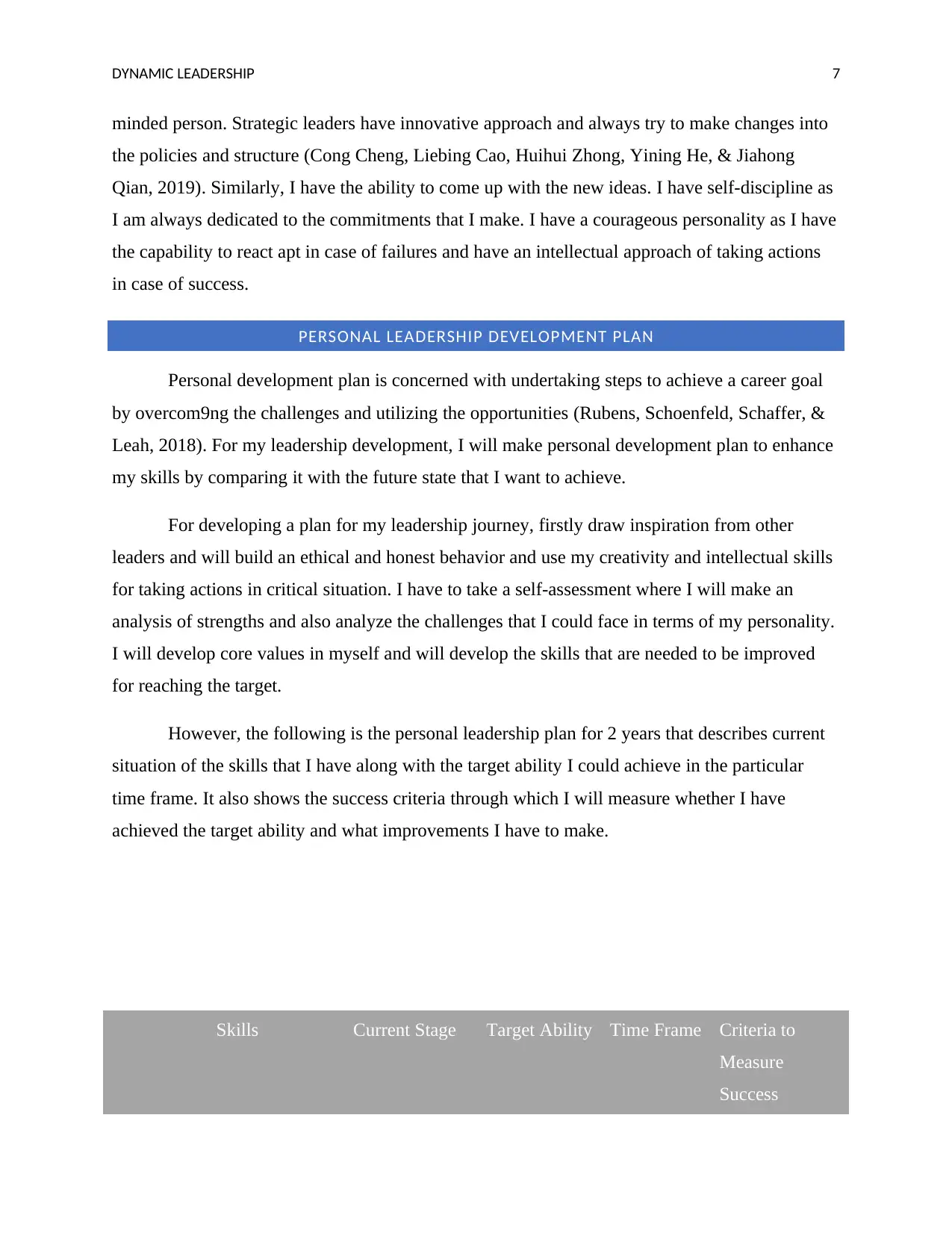
DYNAMIC LEADERSHIP 7
minded person. Strategic leaders have innovative approach and always try to make changes into
the policies and structure (Cong Cheng, Liebing Cao, Huihui Zhong, Yining He, & Jiahong
Qian, 2019). Similarly, I have the ability to come up with the new ideas. I have self-discipline as
I am always dedicated to the commitments that I make. I have a courageous personality as I have
the capability to react apt in case of failures and have an intellectual approach of taking actions
in case of success.
PERSONAL LEADERSHIP DEVELOPMENT PLAN
Personal development plan is concerned with undertaking steps to achieve a career goal
by overcom9ng the challenges and utilizing the opportunities (Rubens, Schoenfeld, Schaffer, &
Leah, 2018). For my leadership development, I will make personal development plan to enhance
my skills by comparing it with the future state that I want to achieve.
For developing a plan for my leadership journey, firstly draw inspiration from other
leaders and will build an ethical and honest behavior and use my creativity and intellectual skills
for taking actions in critical situation. I have to take a self-assessment where I will make an
analysis of strengths and also analyze the challenges that I could face in terms of my personality.
I will develop core values in myself and will develop the skills that are needed to be improved
for reaching the target.
However, the following is the personal leadership plan for 2 years that describes current
situation of the skills that I have along with the target ability I could achieve in the particular
time frame. It also shows the success criteria through which I will measure whether I have
achieved the target ability and what improvements I have to make.
Skills Current Stage Target Ability Time Frame Criteria to
Measure
Success
minded person. Strategic leaders have innovative approach and always try to make changes into
the policies and structure (Cong Cheng, Liebing Cao, Huihui Zhong, Yining He, & Jiahong
Qian, 2019). Similarly, I have the ability to come up with the new ideas. I have self-discipline as
I am always dedicated to the commitments that I make. I have a courageous personality as I have
the capability to react apt in case of failures and have an intellectual approach of taking actions
in case of success.
PERSONAL LEADERSHIP DEVELOPMENT PLAN
Personal development plan is concerned with undertaking steps to achieve a career goal
by overcom9ng the challenges and utilizing the opportunities (Rubens, Schoenfeld, Schaffer, &
Leah, 2018). For my leadership development, I will make personal development plan to enhance
my skills by comparing it with the future state that I want to achieve.
For developing a plan for my leadership journey, firstly draw inspiration from other
leaders and will build an ethical and honest behavior and use my creativity and intellectual skills
for taking actions in critical situation. I have to take a self-assessment where I will make an
analysis of strengths and also analyze the challenges that I could face in terms of my personality.
I will develop core values in myself and will develop the skills that are needed to be improved
for reaching the target.
However, the following is the personal leadership plan for 2 years that describes current
situation of the skills that I have along with the target ability I could achieve in the particular
time frame. It also shows the success criteria through which I will measure whether I have
achieved the target ability and what improvements I have to make.
Skills Current Stage Target Ability Time Frame Criteria to
Measure
Success
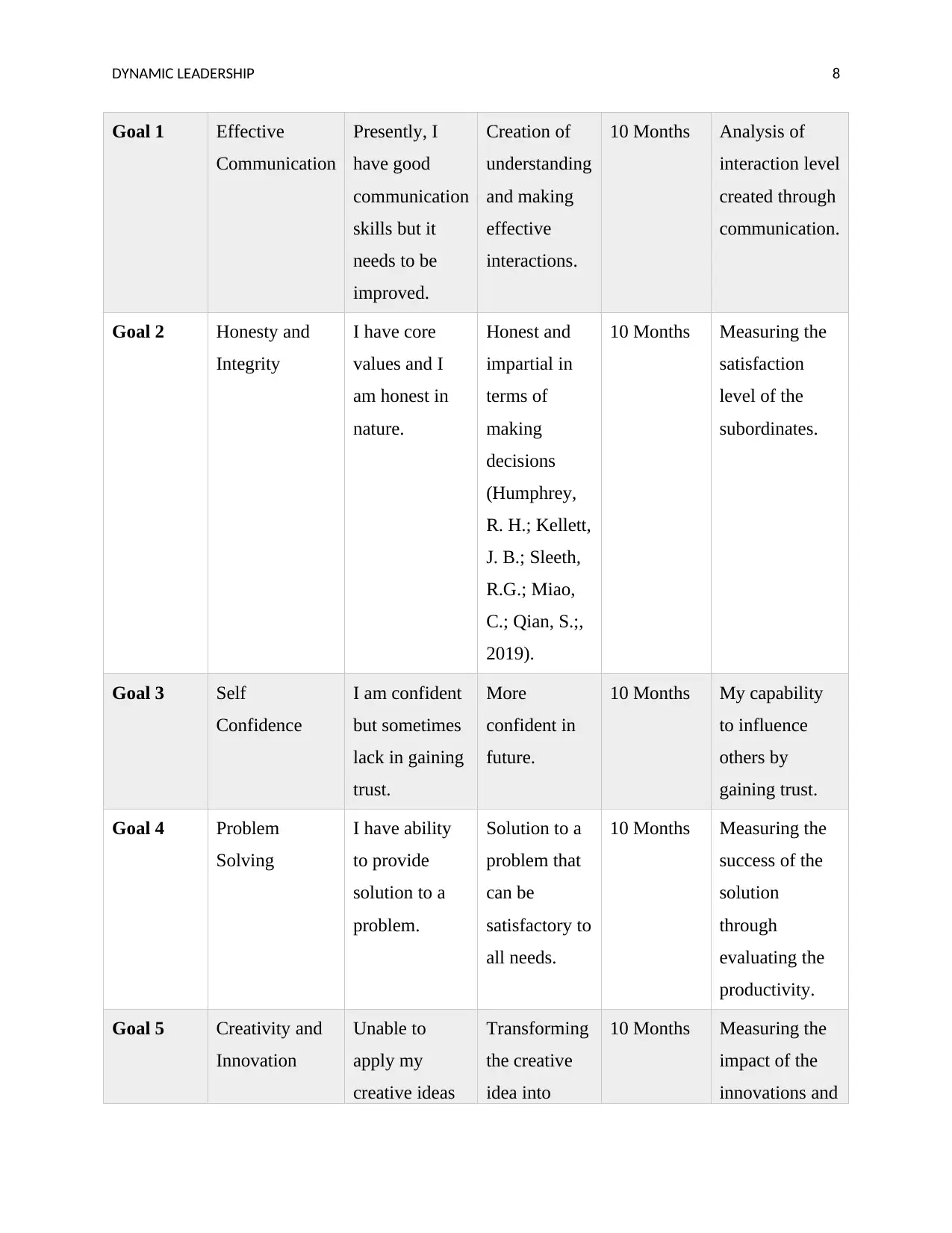
DYNAMIC LEADERSHIP 8
Goal 1 Effective
Communication
Presently, I
have good
communication
skills but it
needs to be
improved.
Creation of
understanding
and making
effective
interactions.
10 Months Analysis of
interaction level
created through
communication.
Goal 2 Honesty and
Integrity
I have core
values and I
am honest in
nature.
Honest and
impartial in
terms of
making
decisions
(Humphrey,
R. H.; Kellett,
J. B.; Sleeth,
R.G.; Miao,
C.; Qian, S.;,
2019).
10 Months Measuring the
satisfaction
level of the
subordinates.
Goal 3 Self
Confidence
I am confident
but sometimes
lack in gaining
trust.
More
confident in
future.
10 Months My capability
to influence
others by
gaining trust.
Goal 4 Problem
Solving
I have ability
to provide
solution to a
problem.
Solution to a
problem that
can be
satisfactory to
all needs.
10 Months Measuring the
success of the
solution
through
evaluating the
productivity.
Goal 5 Creativity and
Innovation
Unable to
apply my
creative ideas
Transforming
the creative
idea into
10 Months Measuring the
impact of the
innovations and
Goal 1 Effective
Communication
Presently, I
have good
communication
skills but it
needs to be
improved.
Creation of
understanding
and making
effective
interactions.
10 Months Analysis of
interaction level
created through
communication.
Goal 2 Honesty and
Integrity
I have core
values and I
am honest in
nature.
Honest and
impartial in
terms of
making
decisions
(Humphrey,
R. H.; Kellett,
J. B.; Sleeth,
R.G.; Miao,
C.; Qian, S.;,
2019).
10 Months Measuring the
satisfaction
level of the
subordinates.
Goal 3 Self
Confidence
I am confident
but sometimes
lack in gaining
trust.
More
confident in
future.
10 Months My capability
to influence
others by
gaining trust.
Goal 4 Problem
Solving
I have ability
to provide
solution to a
problem.
Solution to a
problem that
can be
satisfactory to
all needs.
10 Months Measuring the
success of the
solution
through
evaluating the
productivity.
Goal 5 Creativity and
Innovation
Unable to
apply my
creative ideas
Transforming
the creative
idea into
10 Months Measuring the
impact of the
innovations and
⊘ This is a preview!⊘
Do you want full access?
Subscribe today to unlock all pages.

Trusted by 1+ million students worldwide
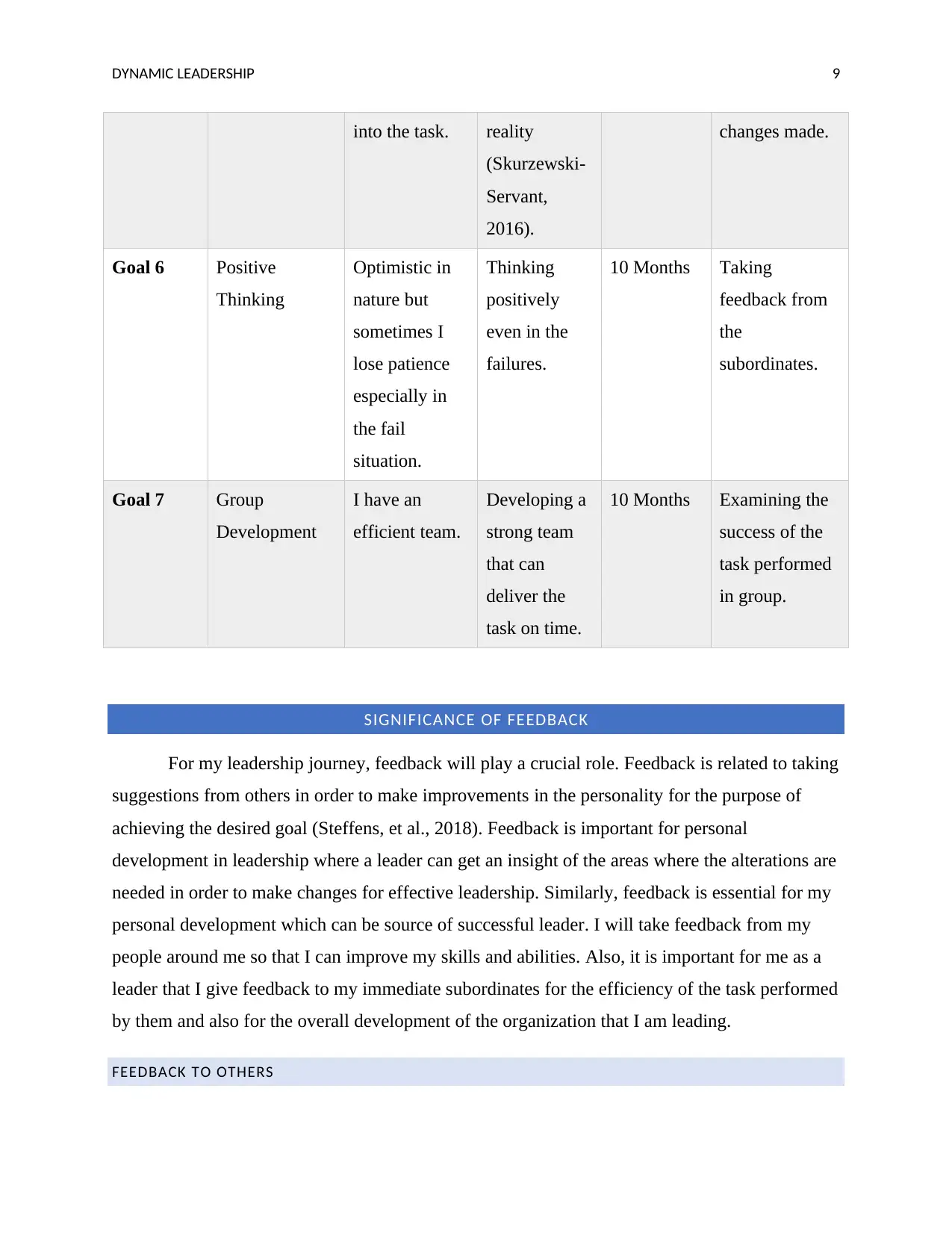
DYNAMIC LEADERSHIP 9
into the task. reality
(Skurzewski‐
Servant,
2016).
changes made.
Goal 6 Positive
Thinking
Optimistic in
nature but
sometimes I
lose patience
especially in
the fail
situation.
Thinking
positively
even in the
failures.
10 Months Taking
feedback from
the
subordinates.
Goal 7 Group
Development
I have an
efficient team.
Developing a
strong team
that can
deliver the
task on time.
10 Months Examining the
success of the
task performed
in group.
SIGNIFICANCE OF FEEDBACK
For my leadership journey, feedback will play a crucial role. Feedback is related to taking
suggestions from others in order to make improvements in the personality for the purpose of
achieving the desired goal (Steffens, et al., 2018). Feedback is important for personal
development in leadership where a leader can get an insight of the areas where the alterations are
needed in order to make changes for effective leadership. Similarly, feedback is essential for my
personal development which can be source of successful leader. I will take feedback from my
people around me so that I can improve my skills and abilities. Also, it is important for me as a
leader that I give feedback to my immediate subordinates for the efficiency of the task performed
by them and also for the overall development of the organization that I am leading.
FEEDBACK TO OTHERS
into the task. reality
(Skurzewski‐
Servant,
2016).
changes made.
Goal 6 Positive
Thinking
Optimistic in
nature but
sometimes I
lose patience
especially in
the fail
situation.
Thinking
positively
even in the
failures.
10 Months Taking
feedback from
the
subordinates.
Goal 7 Group
Development
I have an
efficient team.
Developing a
strong team
that can
deliver the
task on time.
10 Months Examining the
success of the
task performed
in group.
SIGNIFICANCE OF FEEDBACK
For my leadership journey, feedback will play a crucial role. Feedback is related to taking
suggestions from others in order to make improvements in the personality for the purpose of
achieving the desired goal (Steffens, et al., 2018). Feedback is important for personal
development in leadership where a leader can get an insight of the areas where the alterations are
needed in order to make changes for effective leadership. Similarly, feedback is essential for my
personal development which can be source of successful leader. I will take feedback from my
people around me so that I can improve my skills and abilities. Also, it is important for me as a
leader that I give feedback to my immediate subordinates for the efficiency of the task performed
by them and also for the overall development of the organization that I am leading.
FEEDBACK TO OTHERS
Paraphrase This Document
Need a fresh take? Get an instant paraphrase of this document with our AI Paraphraser
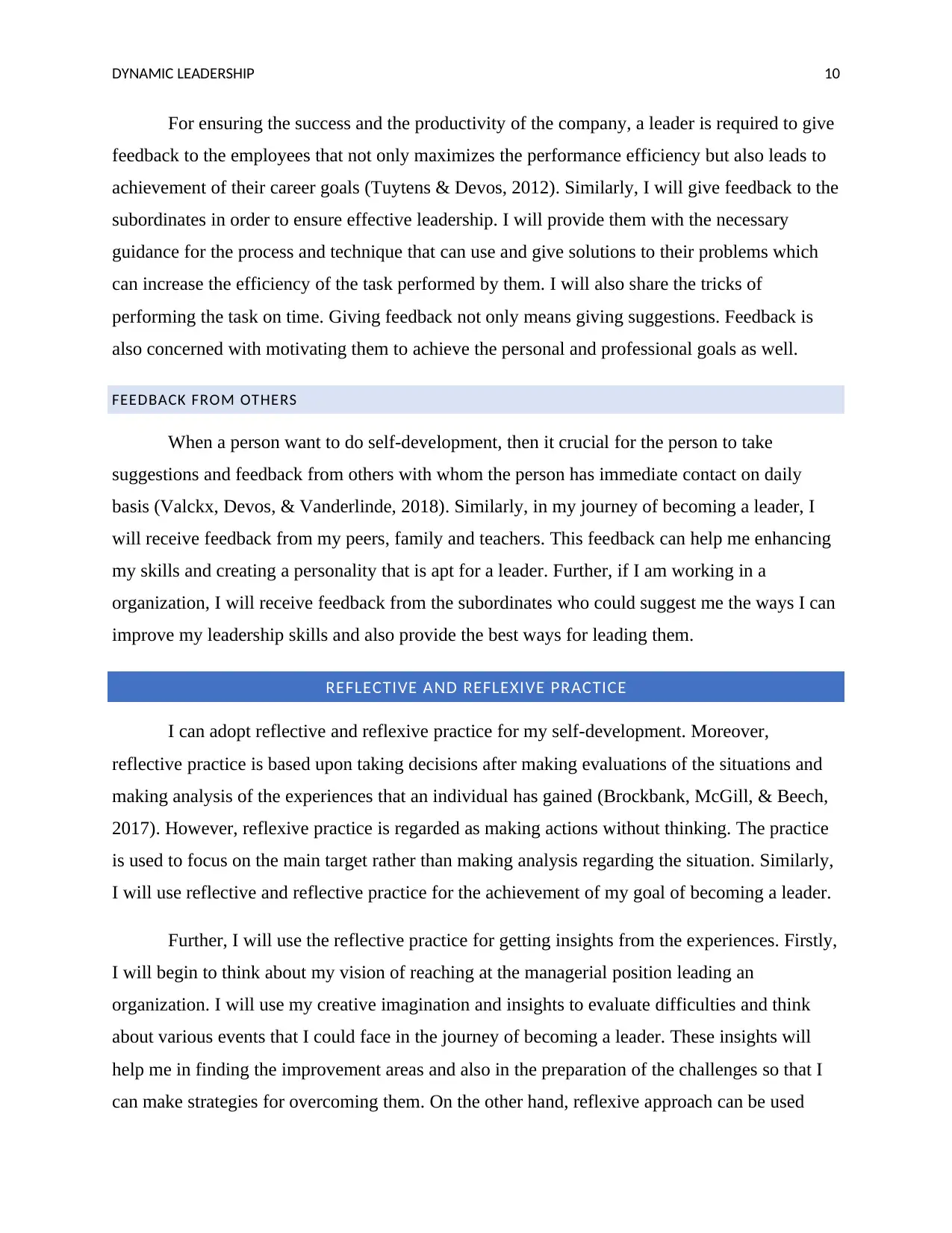
DYNAMIC LEADERSHIP 10
For ensuring the success and the productivity of the company, a leader is required to give
feedback to the employees that not only maximizes the performance efficiency but also leads to
achievement of their career goals (Tuytens & Devos, 2012). Similarly, I will give feedback to the
subordinates in order to ensure effective leadership. I will provide them with the necessary
guidance for the process and technique that can use and give solutions to their problems which
can increase the efficiency of the task performed by them. I will also share the tricks of
performing the task on time. Giving feedback not only means giving suggestions. Feedback is
also concerned with motivating them to achieve the personal and professional goals as well.
FEEDBACK FROM OTHERS
When a person want to do self-development, then it crucial for the person to take
suggestions and feedback from others with whom the person has immediate contact on daily
basis (Valckx, Devos, & Vanderlinde, 2018). Similarly, in my journey of becoming a leader, I
will receive feedback from my peers, family and teachers. This feedback can help me enhancing
my skills and creating a personality that is apt for a leader. Further, if I am working in a
organization, I will receive feedback from the subordinates who could suggest me the ways I can
improve my leadership skills and also provide the best ways for leading them.
REFLECTIVE AND REFLEXIVE PRACTICE
I can adopt reflective and reflexive practice for my self-development. Moreover,
reflective practice is based upon taking decisions after making evaluations of the situations and
making analysis of the experiences that an individual has gained (Brockbank, McGill, & Beech,
2017). However, reflexive practice is regarded as making actions without thinking. The practice
is used to focus on the main target rather than making analysis regarding the situation. Similarly,
I will use reflective and reflective practice for the achievement of my goal of becoming a leader.
Further, I will use the reflective practice for getting insights from the experiences. Firstly,
I will begin to think about my vision of reaching at the managerial position leading an
organization. I will use my creative imagination and insights to evaluate difficulties and think
about various events that I could face in the journey of becoming a leader. These insights will
help me in finding the improvement areas and also in the preparation of the challenges so that I
can make strategies for overcoming them. On the other hand, reflexive approach can be used
For ensuring the success and the productivity of the company, a leader is required to give
feedback to the employees that not only maximizes the performance efficiency but also leads to
achievement of their career goals (Tuytens & Devos, 2012). Similarly, I will give feedback to the
subordinates in order to ensure effective leadership. I will provide them with the necessary
guidance for the process and technique that can use and give solutions to their problems which
can increase the efficiency of the task performed by them. I will also share the tricks of
performing the task on time. Giving feedback not only means giving suggestions. Feedback is
also concerned with motivating them to achieve the personal and professional goals as well.
FEEDBACK FROM OTHERS
When a person want to do self-development, then it crucial for the person to take
suggestions and feedback from others with whom the person has immediate contact on daily
basis (Valckx, Devos, & Vanderlinde, 2018). Similarly, in my journey of becoming a leader, I
will receive feedback from my peers, family and teachers. This feedback can help me enhancing
my skills and creating a personality that is apt for a leader. Further, if I am working in a
organization, I will receive feedback from the subordinates who could suggest me the ways I can
improve my leadership skills and also provide the best ways for leading them.
REFLECTIVE AND REFLEXIVE PRACTICE
I can adopt reflective and reflexive practice for my self-development. Moreover,
reflective practice is based upon taking decisions after making evaluations of the situations and
making analysis of the experiences that an individual has gained (Brockbank, McGill, & Beech,
2017). However, reflexive practice is regarded as making actions without thinking. The practice
is used to focus on the main target rather than making analysis regarding the situation. Similarly,
I will use reflective and reflective practice for the achievement of my goal of becoming a leader.
Further, I will use the reflective practice for getting insights from the experiences. Firstly,
I will begin to think about my vision of reaching at the managerial position leading an
organization. I will use my creative imagination and insights to evaluate difficulties and think
about various events that I could face in the journey of becoming a leader. These insights will
help me in finding the improvement areas and also in the preparation of the challenges so that I
can make strategies for overcoming them. On the other hand, reflexive approach can be used
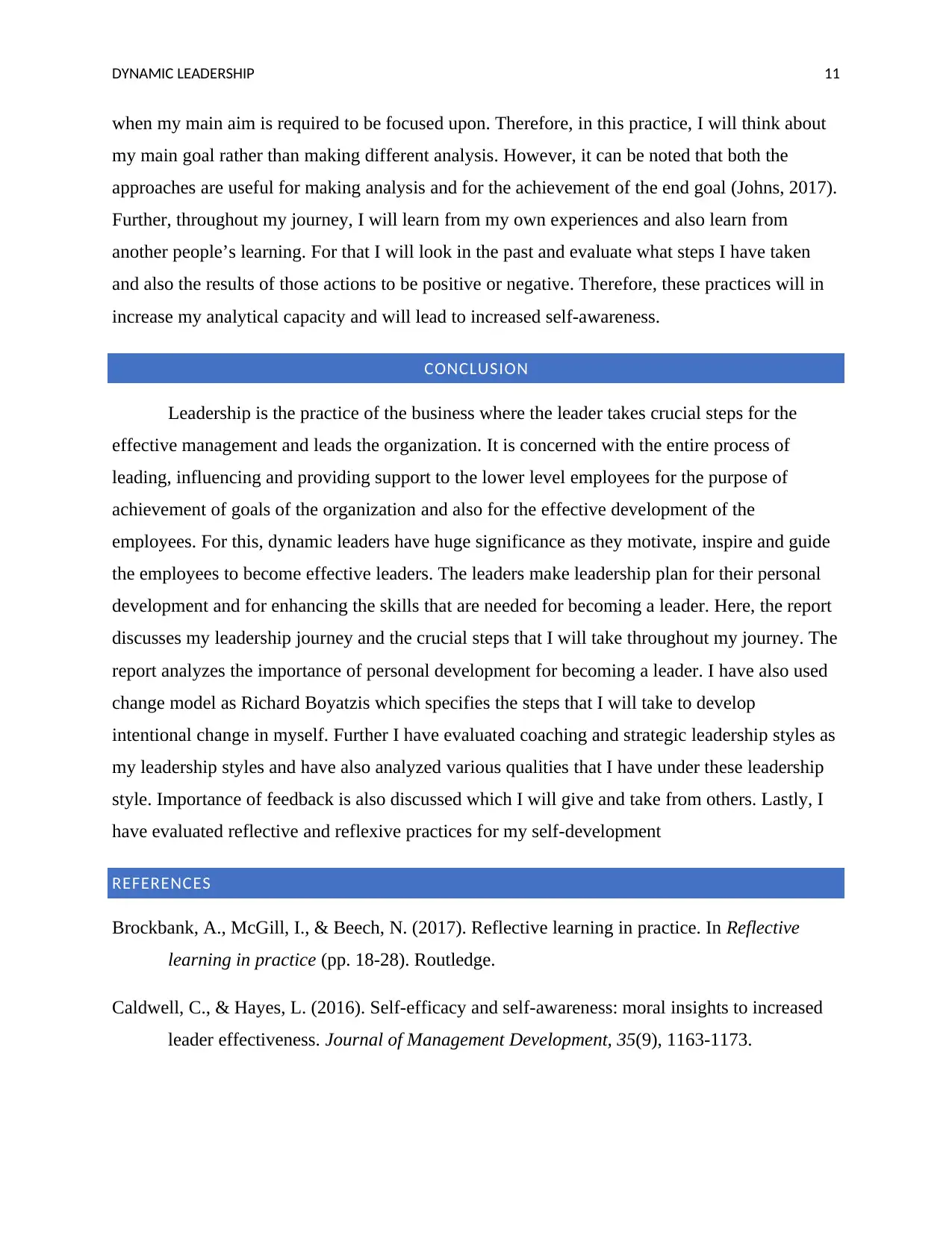
DYNAMIC LEADERSHIP 11
when my main aim is required to be focused upon. Therefore, in this practice, I will think about
my main goal rather than making different analysis. However, it can be noted that both the
approaches are useful for making analysis and for the achievement of the end goal (Johns, 2017).
Further, throughout my journey, I will learn from my own experiences and also learn from
another people’s learning. For that I will look in the past and evaluate what steps I have taken
and also the results of those actions to be positive or negative. Therefore, these practices will in
increase my analytical capacity and will lead to increased self-awareness.
CONCLUSION
Leadership is the practice of the business where the leader takes crucial steps for the
effective management and leads the organization. It is concerned with the entire process of
leading, influencing and providing support to the lower level employees for the purpose of
achievement of goals of the organization and also for the effective development of the
employees. For this, dynamic leaders have huge significance as they motivate, inspire and guide
the employees to become effective leaders. The leaders make leadership plan for their personal
development and for enhancing the skills that are needed for becoming a leader. Here, the report
discusses my leadership journey and the crucial steps that I will take throughout my journey. The
report analyzes the importance of personal development for becoming a leader. I have also used
change model as Richard Boyatzis which specifies the steps that I will take to develop
intentional change in myself. Further I have evaluated coaching and strategic leadership styles as
my leadership styles and have also analyzed various qualities that I have under these leadership
style. Importance of feedback is also discussed which I will give and take from others. Lastly, I
have evaluated reflective and reflexive practices for my self-development
REFERENCES
Brockbank, A., McGill, I., & Beech, N. (2017). Reflective learning in practice. In Reflective
learning in practice (pp. 18-28). Routledge.
Caldwell, C., & Hayes, L. (2016). Self-efficacy and self-awareness: moral insights to increased
leader effectiveness. Journal of Management Development, 35(9), 1163-1173.
when my main aim is required to be focused upon. Therefore, in this practice, I will think about
my main goal rather than making different analysis. However, it can be noted that both the
approaches are useful for making analysis and for the achievement of the end goal (Johns, 2017).
Further, throughout my journey, I will learn from my own experiences and also learn from
another people’s learning. For that I will look in the past and evaluate what steps I have taken
and also the results of those actions to be positive or negative. Therefore, these practices will in
increase my analytical capacity and will lead to increased self-awareness.
CONCLUSION
Leadership is the practice of the business where the leader takes crucial steps for the
effective management and leads the organization. It is concerned with the entire process of
leading, influencing and providing support to the lower level employees for the purpose of
achievement of goals of the organization and also for the effective development of the
employees. For this, dynamic leaders have huge significance as they motivate, inspire and guide
the employees to become effective leaders. The leaders make leadership plan for their personal
development and for enhancing the skills that are needed for becoming a leader. Here, the report
discusses my leadership journey and the crucial steps that I will take throughout my journey. The
report analyzes the importance of personal development for becoming a leader. I have also used
change model as Richard Boyatzis which specifies the steps that I will take to develop
intentional change in myself. Further I have evaluated coaching and strategic leadership styles as
my leadership styles and have also analyzed various qualities that I have under these leadership
style. Importance of feedback is also discussed which I will give and take from others. Lastly, I
have evaluated reflective and reflexive practices for my self-development
REFERENCES
Brockbank, A., McGill, I., & Beech, N. (2017). Reflective learning in practice. In Reflective
learning in practice (pp. 18-28). Routledge.
Caldwell, C., & Hayes, L. (2016). Self-efficacy and self-awareness: moral insights to increased
leader effectiveness. Journal of Management Development, 35(9), 1163-1173.
⊘ This is a preview!⊘
Do you want full access?
Subscribe today to unlock all pages.

Trusted by 1+ million students worldwide
1 out of 14
Related Documents
Your All-in-One AI-Powered Toolkit for Academic Success.
+13062052269
info@desklib.com
Available 24*7 on WhatsApp / Email
![[object Object]](/_next/static/media/star-bottom.7253800d.svg)
Unlock your academic potential
Copyright © 2020–2025 A2Z Services. All Rights Reserved. Developed and managed by ZUCOL.




